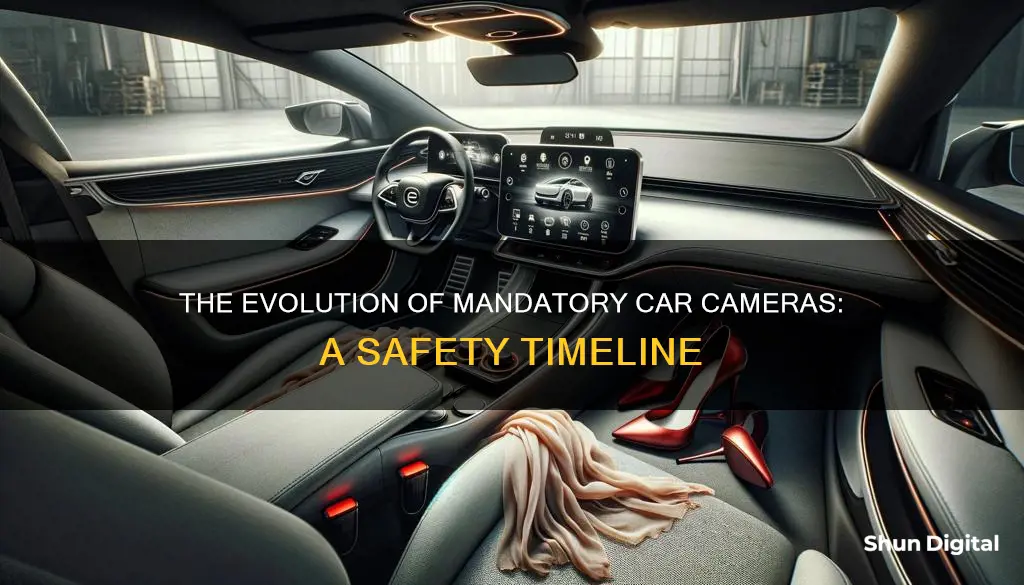
Car cameras, also known as backup, reversing, or rearview cameras, became mandatory in the US on May 1, 2018. This was the result of a bill passed by Congress in 2008, which was then mandated by the National Highway Transportation Safety Agency in 2014. The rule requires all newly manufactured vehicles sold in the US to be equipped with backup cameras as a standard feature, aiding drivers in reversing and reducing the rear blind spot, which has been described as a killing zone.
| Characteristics | Values |
|---|---|
| Date car cameras became mandatory | May 1, 2018 |
| Country | United States |
| Vehicle type | All new vehicles |
| Camera type | Backup/rearview cameras |
| Purpose | Improve safety, reduce accidents and enhance visibility |
| Legislation | Cameron Gulbransen Kids Transportation Safety Act (2008) |
| Mandate | National Highway Transportation Safety Agency (2014) |
What You'll Learn
- Backup cameras have been mandatory on all new US vehicles since May 1, 2018
- The Cameron Gulbransen Kids Transportation Safety Act was passed in 2008
- Congress passed the bill for backup cameras in 2008, but implementation was delayed
- Backup cameras were first available in 1956, on the Buick Centurion concept car
- Advocates for the rule hope to prevent drivers from backing into people

Backup cameras have been mandatory on all new US vehicles since May 1, 2018
The National Highway Traffic Safety Administration (NHTSA) reports that over 200 people are killed annually in accidents that occur while the driver is backing up and unable to see behind the vehicle. Backup cameras can help to prevent these accidents by showing the driver the blind spots that traditional rearview mirrors cannot.
The 2019 study by the Insurance Institute for Highway Safety (IIHS) concluded that while "rear cameras alone reduced collision rates by only 5%, combining a camera with rear parking sensors reduced the backup collision rate by 42%, and adding automatic rear braking to the camera and parking sensors lowered the collision rate by 78%."
Some modern reverse systems also provide audible warnings and even automatic braking if the car that is reversing is in the path of other vehicles or objects, such as pedestrians or bicycles.
It is important to note that this law only applies to newly manufactured vehicles sold in the US. Used car dealerships are not required to install backup cameras on their vehicles, although some may choose to do so as an added feature.
Surveillance Cameras: What You Need to Know
You may want to see also

The Cameron Gulbransen Kids Transportation Safety Act was passed in 2008
Car cameras became mandatory in the US on May 1, 2018, when a law came into effect requiring all new cars sold to have backup cameras and screens. However, the journey to this law being passed began much earlier.
The Act ordered the National Highway Transportation Safety Agency (NHTSA) to issue a standard for improving rear visibility in vehicles by 2011. Unfortunately, the proposed standard was stalled for several years within the White House's Office of Information and Regulatory Affairs. It took a coalition of advocacy groups filing a lawsuit against the U.S. Department of Transportation in 2014 to finally prompt the issuance of a rule, with a deadline of May 1, 2018, for full implementation.
While the law requiring backup cameras in all new cars sold in the U.S. was a significant step forward, it is important to note that the technology behind rearview cameras is not new. The 1956 Buick Centurion concept car, unveiled by General Motors in 1956, was the first vehicle to feature a reverse camera. Despite this early innovation, it would take decades for backup cameras to become standard in the automotive industry.
The impact of the Cameron Gulbransen Kids Transportation Safety Act has been significant. According to the National Highway Traffic Safety Administration, more than 200 people are killed annually in "backover" crashes, with over half of the victims being children under 5 or adults over 70. By mandating backup cameras, the Act has helped to address this issue and improve safety for the most vulnerable.
Moto Z2's Dual Camera Mode: How Does It Work?
You may want to see also

Congress passed the bill for backup cameras in 2008, but implementation was delayed
In 2008, Congress passed the Cameron Gulbransen Kids Transportation Safety Act, named after a child who was killed when an SUV backed into him in 2002. The bill was signed into law by then-President George W. Bush. It mandated that the National Highway Transportation Safety Agency (NHTSA) issue a standard for improving drivers' ability to detect pedestrians behind their vehicles. Despite the bill, NHTSA's proposed standard was stalled for several years in the White House's Office of Information and Regulatory Affairs.
In 2014, a coalition of advocacy groups filed a lawsuit against the U.S. Department of Transportation, citing an "unreasonable delay" in creating backup-camera rules. The cost was one of the points at issue, with NHTSA estimating the backup camera would cost the auto industry an extra $58 to $203 per vehicle. However, safety groups argued that the equipment would cut between 95 and 112 of the nearly 300 backup deaths per year in the U.S., with about 100 of those being children under 5 years old.
Following the lawsuit, the Department of Transportation announced in March 2014 that all new cars sold in the U.S. must be equipped with backup cameras and screens that show drivers what's behind their vehicles while in reverse gear. The effective date for this mandate was set for May 2018, providing manufacturers with time to implement the technology. This delay in implementation was to allow car manufacturers time to implement the technology and ensure that all new cars complied with the ruling.
While backup cameras were not federally mandated until 2018, many manufacturers had already started to include them as optional or standard equipment before that date. Some manufacturers, like Acura, Buick, Honda, and Infiniti, were making backup cameras standard in their vehicles as early as 2015.
The Guardian Camera: Battery Life Explored
You may want to see also

Backup cameras were first available in 1956, on the Buick Centurion concept car
Backup cameras, also known as reverse cameras or rearview cameras, have been mandatory in all new American-made cars since May 1, 2018. However, the technology behind these cameras has been around for much longer.
The first-ever car to feature a backup camera was the 1956 Buick Centurion concept car. Unveiled at the General Motors Motorama in January 1956, the Centurion was a futuristic concept car that boasted several impressive features, including bucket seats and aviation-inspired design cues. But its most notable feature was the rear-view camera, which allowed the driver to see behind the car without turning around. The Centurion's designers were so confident in this technology that they didn't include any mirrors on the car.
The Centurion's backup system was quite bulky compared to modern versions. It consisted of a large TV camera lens mounted on the rear of the car and a small TV screen located on the dashboard. Despite being ahead of its time, this technology didn't catch on right away, even at Buick. It would be several decades before backup cameras became standard in production vehicles.
The 1956 Buick Centurion concept car was truly a pioneer in automotive technology, and its impact can still be felt today. While the specific dates of when car cameras became mandatory are recent, the technology has been in development for over 60 years.
Focusing a Polaroid Land Camera 101: Tips and Tricks
You may want to see also

Advocates for the rule hope to prevent drivers from backing into people
Since May 2018, all new cars sold in the US and Canada have been required by law to have backup cameras. This rule was advocated for by groups such as KidsAndCars.org, who work to prevent accidents involving children and vehicles.
Backup cameras are designed to aid drivers in reversing and reducing the rear blind spot, which has been described as a "killing zone" due to the accidents it contributes to. This blind spot is not visible to the driver through the use of mirrors alone, and backup cameras help to show this area, enhancing safety.
The National Highway Traffic Safety Administration (NHTSA) reports that more than 200 people are killed annually in "backover" crashes, with over 12,000 more injured. Of those killed, more than half are children under 5 years old or adults 70 and older. The NHTSA also reports that backup cameras have already been found to reduce backup-related crashes by 17%.
While backup cameras are an important safety feature, they should not be the only view a driver uses when backing up. It is critical that drivers do not become overly dependent on them, as they only provide a limited view of the surroundings. To ensure safety, drivers should also walk around the vehicle before backing up to ensure the path is clear and use mirrors and blind spots to check for people, vehicles, or objects entering their path.
By combining backup cameras with other safety measures, such as parking sensors and automatic rear braking, the backup collision rate can be significantly reduced. A 2019 study by the Insurance Institute for Highway Safety (IIHS) found that adding parking sensors to a camera system reduced backup collisions by 42%, and adding automatic rear braking to this system lowered the collision rate by 78%.
Travel Light: Camera Gear, Luggage Insert
You may want to see also
Frequently asked questions
Car cameras became mandatory in the US on May 1, 2018.
No, car cameras were not always mandatory in the US. They became mandatory in 2018.
Backup cameras, also known as reverse or rearview cameras, became mandatory in the US in 2018.
Backup cameras became mandatory in the US to improve safety by reducing the number of accidents and fatalities caused by backing up.
Yes, backup cameras were available before they became mandatory in the US. Some manufacturers offered them as optional or standard equipment, and aftermarket options were also available.







